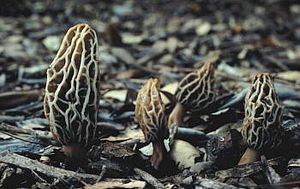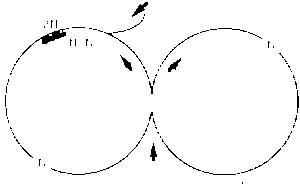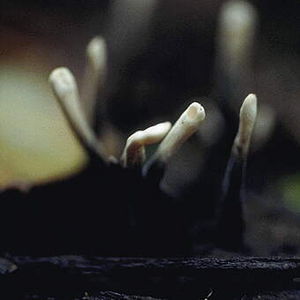Ascomycota: Difference between revisions
Slonczewski (talk | contribs) No edit summary |
No edit summary |
||
| Line 15: | Line 15: | ||
{| | {| | ||
| height="10" bgcolor="#FFDF95" | | | height="10" bgcolor="#FFDF95" | | ||
'''NCBI: [http://www.ncbi.nlm.nih.gov/Taxonomy/Browser/wwwtax.cgi?mode= | '''NCBI: [http://www.ncbi.nlm.nih.gov/Taxonomy/Browser/wwwtax.cgi?mode=Tree&id=147556&lvl=3&lin=f&keep=1&srchmode=1&unlock Taxonomy] Genome ''' | ||
|} | |} | ||
Revision as of 13:21, 22 August 2006
A Microbial Biorealm page on the phylum Ascomycota
Classification
Higher order taxa:
Eukaryota; Fungi/Metazoa group; Fungi
Species:

Saccharomyces cervisae, Morchella esculentum, Penicillium chrysogenum
|
NCBI: Taxonomy Genome |
Description and Significance
Ascomycota, also known as sac fungi, is a recently discovered class. In fact, it was once classified within Deuromycota. Ascomycota is a sister group to basidomycota. This classification makes up more than 75% of fungi. It is a very general category to describe a wide number of organisms, including yeasts. There are many famous and infamous organisms: Saccharomyces cervisiae (baker's yeast), Penicillium chrysogenum (penicillin), Morchella esculentum (morels), Neurospora crassa ("one-gene-one-enzyme" organism), Aspergillus flavus (aflatoxin), Candid albicans (which causes thrush, diaper rash, and vaginitis), and Cryphonecrita parasitica (a disease affecting chestnut trees). Although morels and truffels (euascomycetes) are found here, mushrooms are rare.
Ascomycota were established during the coal age, over 300 million years ago. Early fossils are not easy to recognize, because these early organisms lacked ascoma. The earliest fossiles are in fact controversial because their age of deposition predates estimates of Ascomycota origin.
Some of the most famous Ascomycota are truffels and morels. Morels camouflage easily, with black morels blending into forest landscapes and white morels within more urban locations. In addition, Ascomycota contains fake morels. Within the same order as morels are the cup fungi. Unlike morels however, these fungi often to not have stalks. The Orange Peel Fungus is an example of the cup fungi, as well as its stalked cousin, the Stalked Orange Peel Fungus. Another group is the Flash Fungi, which is known for a species called the Candlesnuff Fungus.
Genome Structure
There are numerous organisms within Ascomycota, and each species has a different genome structure.
Cell Structure and Metabolism

The bodies of Ascomycota are eukaryotic cells surrounded by a wall consisting of chitin and beta glucans. They can be single-celled (yeasts) or filamentous (hyphal) organisms. In addition, they can also be dimorphic. The yeasts grow by budding or fission, while hyphae branch out. Most are haploid, but some can be diploid. Spores are stored in cases (asci), which release clouds of spore smoke. Nucelar fusion and meisos take place within the ascus.
Ascomycota are heterotrophic, obtaining nutrients from both dead or living organisms. In addition, these fungi are capable of consuming almost any liquid, as long as there is water present in it.
Ascomycota have more than one reproductive option. Sexual reproduction takes place within ascospores or meiospores, and asexually with condia or meitospores. Some must outbreed (heterothallic), some must self breed (homothallic), and some can do both. Meitospores usually simply reproduce the parent organism, but can also act as gametes for fertilizatin. Reproduction takes place in the ascus, with one round of mitosis following meiosis. This leaves eight nuclei and eight ascospores.
Ecology

Although certain species live in very specific locations, Ascomycota can be found on all continents. They often form symbiotic relationships with algae, plant roots, and the leaves or stems of plants. However, they do not limit these relationships to plant organisms; they are also known to form them with arthropods. While Ascomycota includes many useful organisms such as fission yeast, baker's yeast, morels, and truffels, it can also account for most animal and plant pathogens. Ascomycota contains the species Magnaporthe grisea, which is considered the most destructive pathogen of rice. Dean et. al. (2005) drafted a sequence of this specie's genome in an attempt to better understand its infectious qualities. Ascomycota play a large role in recycling dead plant material.
Many Ascomycota species are useful beyond their conventional functions. Some species, particularly yeasts, have been used in genetics research. For example, a recent experiment by Conrad et. al. (2005) used Saccharomyces cervisae to study DNA replication. Other researchers, such as R. Kellermayer (2005) have noted the ways in which Saccharomyces cervisae is useful in studying genetic mutations within the context of Hailey-Hailey disease. Cruyssen et. al. (2005) have used this species in their work on Crohn's disease.
References
Kornfeld, Ari. Natural Perspective.
Taylor, John W., Joey Spatafora and Mary Berbee. "Ascomycota: Sac Fungi." Tree of Life Web Project.
